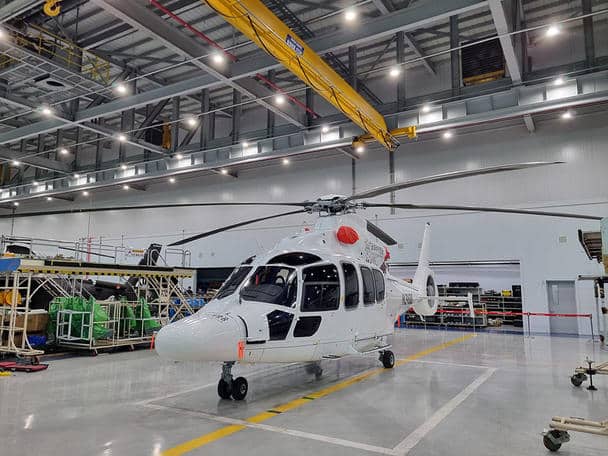Aerospace
Airbus and Korea Aerospace Industries deliver first Light Civil Helicopter
Airbus and Korea Aerospace Industries deliver first Light Civil Helicopter

Following certification in September of this year, Airbus Helicopters and Korea Aerospace Industries (KAI) have now given the first Light Civil Helicopter (LCH) to a local operator, Gloria Aviation. This helicopter, which will be used to support vital life-saving operations in Jeju, will go into service in December this year in an emergency medical services configuration.
This key milestone came on the back of a successful industrial partnership which started in 2015 when the two companies jointly collaborated on the LCH and Light Armed Helicopter (LAH) development programmes.
In July 2019, the LAH prototype successfully completed its first flight, and it will soon be certified. The Republic of Korea Army will be able to purchase the helicopter in serial form after this successful qualification, which Airbus and KAI will jointly begin by the end of 2022.
Airbus and KAI are preparing future cooperative development programmes on the foundation of the successful completion of the LAH development. In addition to utilizing KAI’s well-established local industrialization capabilities in the nation, these helicopter programmes will make use of Airbus’ technical competence in the areas of helicopter propulsion systems and flight control systems.
The two firms originally began their extensive industrial collaboration in 2006 when they collaborated on the Korean Utility Helicopter and LCH/LAH development programmes. The LCH/LAH are next-generation 5-tonne class helicopters that were created to satisfy Korean requirements for local deployment in both the civil and military sectors.
The World’s Top 10 Airlines of 2022 – World Airline Awards(Opens in a new browser tab)
With additional orders for future deliveries, the two parties’ long-lasting collaboration has also resulted in the supply of approximately 250 kits to KAI.
10 facts about the Light Combat Helicopter (LCH) made by Indian HAL. (Opens in a new browser tab)

Aerospace
Boeing Transfers Rocket Stage to NASA, Paving Way for Human Moon Mission

Boeing has achieved a significant milestone by providing NASA with the second core stage of the Space Launch System (SLS) rocket.
This crucial component, crafted at NASA’s Michoud Assembly Facility (MAF), is set to propel the Artemis II crew into lunar orbit, marking humanity’s return to deep space after a 50-year hiatus.
The monumental Boeing-built rocket stage, the largest element of the Artemis II mission, will embark on a journey aboard the Pegasus barge, traveling 900 miles to NASA’s Kennedy Space Center.
Comparison of two legendary aircraft B777x vs B747 aircraft:Click here
Upon arrival, it will be meticulously integrated with other essential Artemis II components, including the upper stage, solid rocket boosters, and NASA’s Orion spacecraft within the iconic Vehicle Assembly Building. This intricate integration process is a vital step toward the eagerly anticipated Artemis II launch, slated for 2025.
“Boeing-built products helped land humankind on the moon in 1969, and we’re proud to continue that legacy through the Artemis generation,” remarked Dave Dutcher, vice president and program manager for Boeing’s SLS program. “Together, with NASA and our industry partners and suppliers, we are building the world’s most capable rocket and paving the way to deep space through America’s rocket factory in New Orleans.”
NASA, Lockheed Martin Reveal X-59 Quiet Supersonic Aircraft:Click here
The delivery of Core Stage 2 marks a significant achievement in the evolution of the SLS rocket. Towering over 200 feet and powered by four RS-25 engines, this core stage, coupled with two solid-fueled booster rockets, will generate a staggering 8.8 million pounds of thrust. This immense power is crucial to launching Artemis II and future missions into the vast expanse of space.
The SLS rocket stands unparalleled in its capability to transport both crew and substantial cargo to the moon and beyond in a single launch. Its extraordinary capacity will facilitate the delivery of human-rated spacecraft, habitats, and scientific missions to destinations including the moon and Mars, ushering in a new era of space exploration.
-

 Travel1 week ago
Travel1 week agoAir India to Expand US Operations with Three New Routes After a Decade
-

 Travel2 weeks ago
Travel2 weeks agoWhy We Should Avoid These Stamps in a Passport
-

 Airlines1 month ago
Airlines1 month agoInvestigations Reveal Fake Chinese Titanium in Boeing and Airbus Jets
-

 Tech4 weeks ago
Tech4 weeks agoChina’s CATL Plans 1,800-Mile Electric Plane Launch by 2027
-

 Airport3 days ago
Airport3 days agoTop 10 Largest Airports in the World by Size
-

 Aerospace4 weeks ago
Aerospace4 weeks agoChina’s Fighter Jets Turn Wings into Autonomous Drones
-

 Airlines4 days ago
Airlines4 days agoAir India Rolls Out A350s for Delhi-New York JFK and Newark Routes
-

 Defence3 weeks ago
Defence3 weeks agoBoeing Enhances Chinook with New Engines and Block II Upgrades at $96 Million







